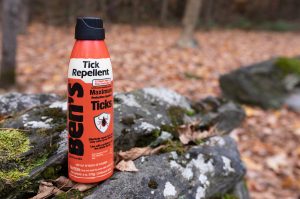Littleton, NH, July 7, 2020 – Lyme disease is the most prevalent vector-borne disease in the U.S. according to the Centers for Disease Control and Prevention, with approximately 300,000 new cases each year. With warm weather and COVID-19 restrictions driving people outdoors, protection with effective tick and insect repellent, as well as education and awareness will be crucial tools in order to stay safe and tick-free.
Ben’s® is an industry-leading producer of insect and tick repellent based in New Hampshire’s White Mountains where ticks are especially common. Ben’s line of repellents for skin, clothing and gear expands this year to include a tick-specific formula with Picaridin in time for tick season.
“At Ben’s, we believe that protection against ticks is the first line of defense in preventing ticks and tick-borne diseases,” says Katie Jones, brand manager for Ben’s. “This year we are proud to launch a tick-specific formula developed and tested in the harshest tick and insect conditions here in New Hampshire.”
Ben’s Tick Repellent 6oz Eco-Spray is an EPA-registered solution with CDC-recommended Picaridin for repelling disease-carrying ticks. The field-tested tick spray features a 20% Picaridin formula designed to repel ticks that may carry Lyme disease and other tick-borne diseases. Also in the Ben’s line of tick and insect protection, Ben’s® Clothing and Gear 24oz Spray repels and kills biting insects on contact with its 0.5% permethrin formula, turning clothing and gear into an extra layer of insect protection. Ben’s® Tick Repellent 6oz Eco-Spray and Ben’s® Clothing and Gear 24oz Spray are available for purchase on Amazon.com and select retailers nationwide.
“While protection is necessary, awareness and education are also imperative in order to stay tick-free when exploring outdoors. Leading tick resources like those offered by Dr. Thomas Mather’s team at the University of Rhode Island’s TickEncounter Resource Center (TERC) provide critical education tools to stay tick-free,” continues Jones.
TERC takes user-submitted tick data from nearly 10,000 people across North America each year as part of their TickSpotters program to develop the most useful tick education and prevention messaging for broader audiences specific to their location.
“Tick education is critical in knowing what type of ticks inhabit the places where you live and play and what you can do to prevent contracting a tick-borne disease,” says Dr. Thomas Mather, director of the University of Rhode Island’s Center for Vector-Borne Disease and TERC. “With the help of TickSpotters, we’ve been able to listen to tick bite victims and respond to each one accordingly with a course of action. We use what we learn to design resources and messaging for the hundreds of thousands of people who check our TickEncounter website or social media channels.”
TERC encourages those spending time outdoors to be aware of its five TickSmart™ actions to remain vigilant, proactive and protected:
- Know the kind of ticks active throughout the year where you live, and identify any ticks you find biting
- Perform daily tick checks, especially checking below the belt for tiny nymph ticks
- Turn play clothes and other outdoor clothes into tick repellent clothes
- Treat your yard with tick-killing insecticides
- Protect your pet with pest-control management products
Please direct all media inquiries to Account Manager Ethan Peck at ethan.peck@rygr.us.












